Cyanobacteria in Sustainable Agriculture
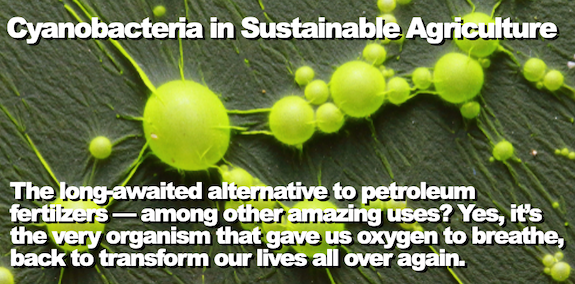
By: Dr. Randy Simpson
Expert, Lee Enterprises Consulting
Special to The Digest
Cyanobacteria are a group of photosynthetic bacteria that can live in diverse environments, such as soil, water, and rocks. Handled properly, they can have several beneficial effects on crop growth, including helping control plant disease, reducing pest damage, increasing crop quality, and improving crop yields.
Some ways cyanobacteria can impact crop growth are through:
- Nitrogen fixation
- Biofertilization
- Biostimulation
- Biocontrol
Nitrogen fixation
Cyanobacteria can fix atmospheric nitrogen into ammonia, a form that plants can use. They do this by using a special enzyme called nitrogenase, which catalyzes the reaction of nitrogen gas and hydrogen to produce ammonia. Cyanobacteria can fix up to 30 kg of nitrogen per hectare per year. They also increase the availability of phosphorus by solubilizing insoluble phosphate in the soil. This process, known as biological nitrogen fixation (BNF), occurs in specialized cells called heterocysts, where oxygen is excluded by a thick cell wall and nitrogenase enzyme is protected from oxygen inhibition. BNF can provide up to 50% of the nitrogen requirement for rice and wheat crops, saving costs and resources for farmers and reducing greenhouse gas emissions from their synthetic nitrogen fertilizer counterparts.
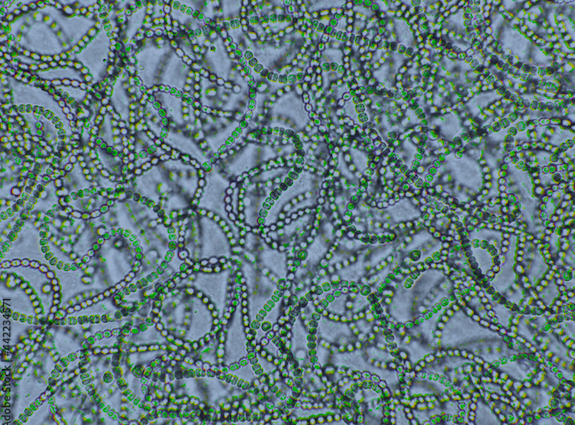
Nitrogen-fixing Nostoc Cyanobacteria Microscopic (Elif Bayraktar/Shutterstock.com)
Biofertilization
Cyanobacteria are widely used as biofertilizers for different crops, as they can enhance soil fertility and crop productivity while reducing the environmental impact of chemical fertilizers. Several studies have demonstrated the effectiveness of cyanobacteria as biofertilizers for different crops under various conditions, with some even showing an increase in rice yield and quality of 10-40%. Cyanobacteria also secrete polysaccharides, organic acids, and enzymes which improve soil structure, porosity, water retention and aeration. Cyanobacteria can also increase soil microbial diversity and activity by establishing symbiotic or associative relationships with other microorganisms.
Biostimulation
Biostimulation is a process that enhances the natural ability of microorganisms to degrade organic contaminants in the environment. This can be achieved by utilizing cyanobacteria by applying them as biofertilizers, bioinoculants, or bioprotectants. Also known as blue-green algae, Cyanobacteria produce oxygen and organic compounds that can stimulate the growth and activity of other degrading bacteria. They can also directly degrade some contaminants, such as pesticides and herbicides, by using them as a source of carbon and nitrogen.
Cyanobacteria do have some limitations and challenges for biostimulation, such as competing with other bacteria for nutrients and space, and potentially producing toxic substances. The mechanisms of biostimulation by cyanobacteria are complex and diverse, involving direct and indirect effects on plant physiology and metabolism.
Cyanobacteria are important biostimulants due to their production of phytohormones, antioxidants, siderophores, carotenoids, flavonoids, phenolics, tocopherols, and glutathione. These phytohormones can regulate plant growth and development, such as cell division, elongation, differentiation, senescence, flowering, fruiting, dormancy, and stress responses. Cyanobacteria also produce carotenoids, flavonoids, phenolics, tocopherols, and glutathione, which can scavenge reactive oxygen species (ROS) and protect plants from oxidative stress caused by environmental factors such as drought, salinity, temperature extremes, UV radiation, or heavy metals. Siderophores can chelate iron and enhance plant nutrition and prevent iron deficiency or toxicity. Cyanobacteria can also improve plant tolerance to abiotic stresses such as drought, salinity, cold, heat, and nutrient deficiency by activating various physiological, biochemical and molecular mechanisms.
Biocontrol
Biocontrol is the use of living organisms to suppress the population or activity of harmful organisms, such as pathogens and pests, in order to protect crops and enhance plant health. Cyanobacteria are photosynthetic prokaryotes that have various biocontrol applications that can improve plant tolerance to abiotic stresses by providing nutrients, increasing water availability and soil quality, producing extracellular polysaccharides, and removing pollutants from soil and water by biodegradation or biosorption. They can also reduce biotic stresses in plants by producing a variety of bioactive compounds with antimicrobial, antifungal, antiviral, antiprotozoal, anti-proliferative, and anticancer activities. Cyanobacteria also release enzymes that degrade the cell walls or hyphae of pathogens, compete for the rhizosphere space and nutrients with pathogens and pests, and activate plant defense responses by interacting with their roots. ISR is a form of plant immunity that enhances the resistance of the whole plant to a broad spectrum of pathogens or pests, without direct contact between the cyanobacteria and the plant pathogens or pests.
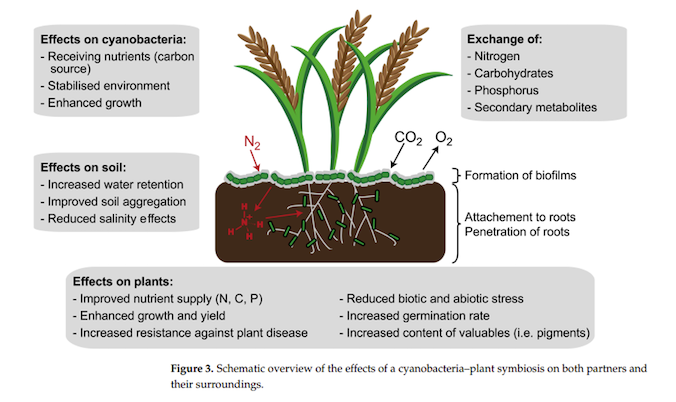
Amit Kishore Singh, Prem Pratap Singh, Vijay Tripathi, Hariom Verma, Sandeep Kumar Singh, Akhileshwar Kumar Srivastava, Ajay Kumar, Distribution of cyanobacteria and their interactions with pesticides in paddy field: A comprehensive review, Journal of Environmental Management, Volume 224, 2018, Pages 361-375, ISSN 0301-4797, https://doi.org/10.1016/j.jenvman.2018.07.039.
Application of Cyanobacteria
Cyanobacteria can be applied to crops and soil in various ways depending on the type of crop, the climatic conditions, and the availability of resources. Application methods include inoculation, biofertilizers, biofilm or biostimulants.
- Inoculation involves introducing cyanobacteria into the soil or plant roots directly, or injecting seeds or seedlings with cyanobacterial cultures before planting.
- Biofertilizers are an additive product that contains living or dormant cyanobacteria cells. Several cyanobacterial strains and species have been utilized as biofertilizers including Nostoc, Anabaena,Aphanizomenon, Oscillatoria, Calothrix, Gloeotrichia, and Tolypothrix.
- Biofilm is a thin layer of cyanobacteria that covers the soil surface and prevents water loss and erosion.
- Biostiumulants come from adding cyanobacteria to crops and soil. Examples include growing cyanobacteria as a green manure or mulch, or integrating cyanobacteria with other beneficial microorganisms.
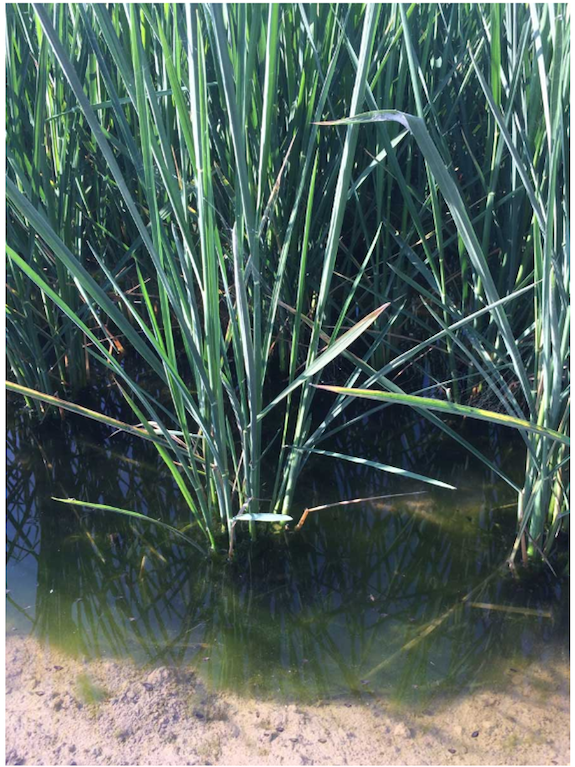
Álvarez, C., Navarro, J. A., Molina-Heredia, F. P., and Mariscal, V. (2020). Endophytic colonization of rice (Oryza sativa L.) by the symbiotic strain Nostoc punctiforme PCC 73102. Molecular Plant-Microbe Interactions, 33(8), 1040–1045. Available at: https://doi.org/10.1094/MPMI-01-20-0015-SC
Cyanobacteria vs. Chemical Fertilizers
Cyanobacterial biofertilizers are less expensive and more sustainable than chemical fertilizers, as they do not require fossil fuels or industrial processes to produce. Chemical fertilizers are synthetic substances that provide plants with essential elements such as nitrogen, phosphorus and potassium, but may also have negative impacts on the environment and soil quality. Cyanobacteria augmentation has an advantage over chemical fertilizers in terms of crop growth, soil fertility, abiotic and biotic stress tolerance, and environmental sustainability. Cyanobacteria can enhance crop growth by increasing the supply of nitrogen, phosphorus and other nutrients to plants, while chemical fertilizers can only provide a limited amount of nutrients to plants and may cause nutrient imbalances or deficiencies if not applied properly. Cyanobacteria can improve soil fertility by improving its physical, chemical and biological properties, while chemical fertilizers can degrade soil fertility by altering each of them.
According to some studies, cyanobacteria-based biofertilizers can be up to one third cheaper than chemical fertilizers. However, there are also some limitations and challenges associated with cyanobacterial farming, such as potential contamination, scalability, and regulation. Therefore, a cost comparison between cyanobacteria and fertilizer for sustainable agriculture should consider both the benefits and the drawbacks of each option being explored.
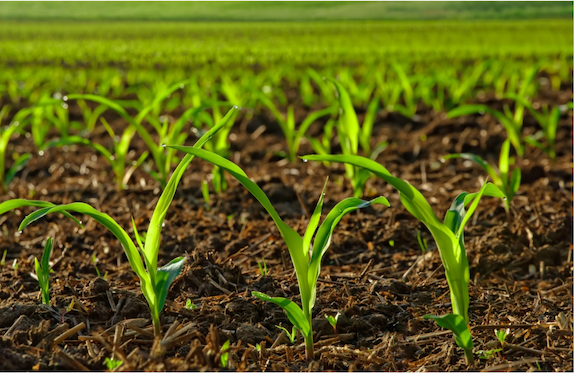
Smileus/Depositphotos
Challenges with Cyanbacteria
The use of cyanobacteria for agricultural purposes has challenges and limitations, such as the selection of suitable strains for different crops and environments, the optimization of cultivation and application methods, the evaluation of the long-term effects and safety of cyanobacterial biostimulation on plants, soil, and human health, the regulation and standardization of cyanobacterial products and practices, and the lack of awareness and acceptance among farmers and consumers about the benefits and safety of cyanobacteria. To optimize the production, application, and performance of cyanobacteria for agricultural purposes, more research and development is needed, including genetic engineering of cyanobacteria for improved nitrogen fixation and stress tolerance, development of novel formulations and delivery systems for cyanobacteria, evaluation of the effects of cyanobacteria on crop physiology and productivity, and assessment of the environmental and socio-economic impacts of cyanobacteria.
Conclusion
Cyanobacteria are versatile microorganisms that can function to improve crop growth in various ways. They are renewable, biodegradable, eco-friendly, and cost-effective. They can reduce soil and water pollution, improve soil structure and fertility, enhance crop yield and quality, and protect plants from pests and diseases. Cyanobacteria also provide nitrogen, nutrients, organic matter, growth regulators, and biocontrol agents to plants, as well as enhance plant resistance and resilience to biotic and abiotic stresses. They are also promising candidates for biofertilizers for various crops due to their multiple beneficial effects on soil fertility and plant growth. While some challenges do exist with Cyanobacteria, they have been successfully used in various agricultural systems, such as rice, wheat, maize, sugarcane, cotton, vegetables, fruits, and flowers, and have a great potential to contribute to global food security as well as agricultural and environmental sustainability in the future.
About the Author. Dr. Randy Simpson has a BS in Mechanical Engineering from the University of Texas, an MS in Environmental Engineering from the Georgia Institute of Technology, a Ph.D. in Microbiology from the University of Iowa Carver College of Medicine. He has over 15 years of experience in process and technology development for large biotech companies and specializes in fermentation, enzyme biocatalysis, and downstream recovery and purification process development at the bench, pilot plant, and commercial scale. He currently serves as a Project Director at Lee Enterprises Consulting, overseeing matters involving Fermentation, Enzymes, Biocatalysis, Biofuels, Alternative Proteins, Wastewater Treatment, Biogas, Technology Transfer & Scale-Up.
Category: Top Stories















